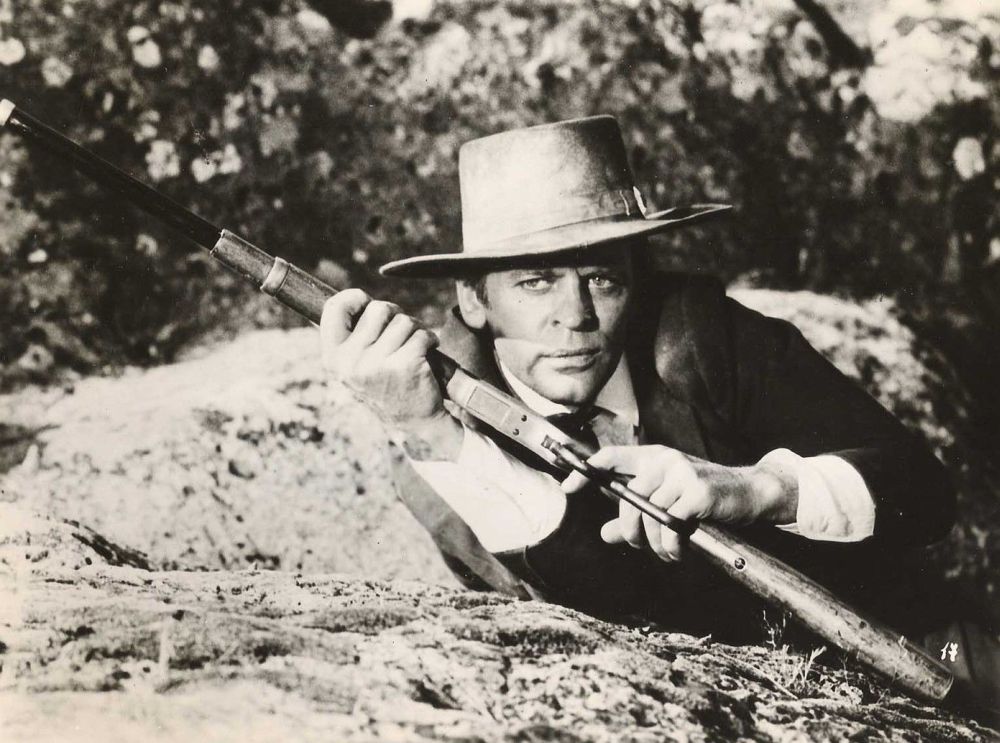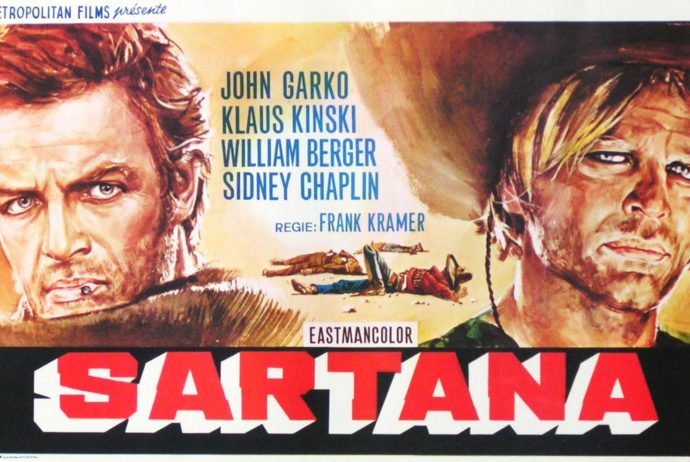Dir: Frank Kramer
Star: John Garko, William Berger, Sidney Chaplin, Klaus Kinski
a.k.a. Sartana
This is officially the first in the Sartana series, though Garko had previously played a character by that name in another film, 1967’s Blood at Sundown. Here, he plays a typically ambivalent spaghetti Western character, who intervenes in the battle for control over the proceeds of various robberies and scams. The central one is a stagecoach robbery, carried out by a Mexican gang under General Mendoza. However, the culprits are ambushed by another group, under Lasky (Berger), though he discovers the supposed gold is nothing but rocks. That’s because it’s part of an insurance scam carried out by local businessmen Stewal (Chaplin, who is Charlie’s son) and Rizzo.
And then there’s Sartana (Garko), who pits the various groups against each other, seeding distrust and suspicion, seeking to profit from the result by swooping in and taking the gold. If this all seems remarkably (and perhaps needlessly) complex, that’s because it is; this is more like watching someone else play a game of Find the Lady than anything. Which means it’s occasionally interesting, frequently confusing or baffling, and the ending comes as no real surprise, with the participants almost certain to lose out.
Garko does a solid enough job in his role, and you can see why the series spawned multiple sequels, as well as innumerable knockoffs. I was especially fond of the way he carries one large, obvious firearm – but almost inevitably does all his damage with a teeny little four-shooter Derringer, he carries secreted on his person. This has a cylinder marked with playing card suits, because… Well, I guess because it’s damn stylish. As is par for this genre, what you do is only about as important as how cool you look and sound while doing it. Which is why the General insists on proclaiming all his names: José Manuel Francisco Mendoza Montezuma de la Plata Carezza Rodriguez.
Well over three hundred words into this, you’ll notice I haven’t even mentioned Klaus’ contribution. That’s because, in contrast to his heavy presence and billing second only to Garko in the poster at the top, his is very much a supporting role. It starts off looking like he will be a main adversary, being the sole survivor after his gang attacks a carriage, only to be interrupted by Sartana. However, that turns out to be a red herring. Kinski’s relatively brief appearance is instead in the role of Morgan, an associate of Lasky. He is dispatched to take out the hero after Lasky and Sartana meet in a barber’s shop – in a cool touch, Morgan prepares to go into battle, by silencing the bells on his spurs with shaving foam.

Morgan follows Sartana to a funeral parlor, where he is hanging out with his comedic sidekick, the local mortician, Dusty (played by Franco Pesce, who reminded me, bizarrely, of Ben Kingsley in Sexy Beast!). Morgan unleashes his weapon of choice, the throwing knife, but this turns out to be his undoing. For after Sartana pushes over a row of coffins, domino-style, Morgan ends up impaled on one of his previously-thrown blades. Less than 40 minutes in, and Kinski has already left, presumably pausing only to cash his check. To be honest, my interest largely went with him; for despite the strong presence of Sartana, too much of this feels lifted, with little or no alteration, from Sergio Leone’s Dollars trilogy.
I think part of the problem is that Sartana exists in a vacuum, with no background information at all provided. While clearly a deliberate decision, and equally obviously, also one of those Leone-inspired choices, it means (particularly for a modern viewer like me, with no pre-knowledge) he’s little more than a blank canvas, that needs to be filled in by the writer and director. And Kramer certainly is no Leone in terms of creating character through action, thinking that Garko’s screen presence is enough, in and by itself. While certainly present, Kramer is mistaken, not least in failing to give his central character a strong adversary, in order to set up dramatic tension.
While I’ll confess to being biased, this likely would have been improved if the film’s structure has reflected that of the poster, with Garko and Kinski facing off over its entire course. Although this was the first of four times the pair would appear together: they also did so in 5 per l’inferno (1969), Il venditore di morte (1971) and the second Sartana film, Sartana the Gravedigger. Even though I found this entry jumbled and confusing, there was enough appeal in the main character, that I’ll likely not be burying Gravedigger at the bottom of my “To-do” list.
